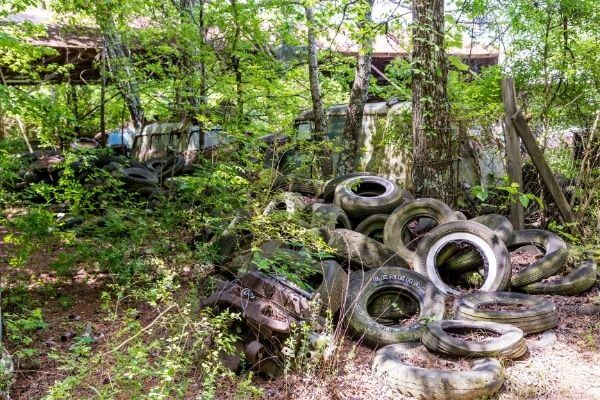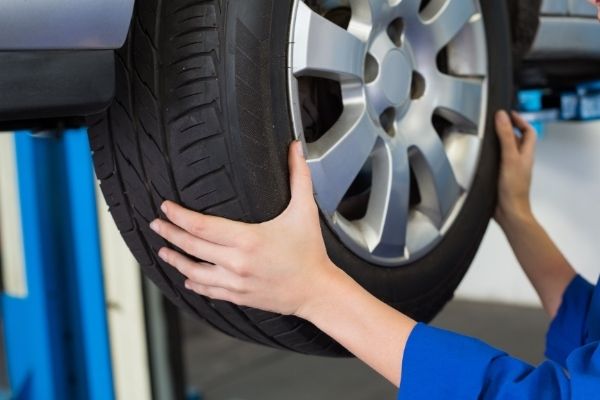I am sure we all agree that our lives would be quite different without tires. Most of us rely on them everyday to get us from A to B. Life would be quite different without them. The problem is that sooner or later, tires reach their end of life. When this happens, recycling tires is very important.
On average, the US disposes of more than 300 million tires per year, while 48 million tires reach their end-of-life every year in Australia. What happens to tires and how can we help dispose of them appropriately.
Read on to learn more about tires, what they are made of, how they can be recycled, and what you can do to reduce your impact.
What are tires made of?
Modern tires are made from synthetic rubber, natural rubber, fabric, wire, and various chemicals.
Natural rubber is harvested from rubber trees. To collect the rubber, incisions are made in the bark of the rubber trees, causing the tree to produce a milky, sticky liquid. This liquid also referred to as latex, is collected and refined into rubber.
Synthetic rubber is a polymer made from petroleum byproducts. It has some different chemical and physical properties to natural rubbers and therefore is a better option for some applications. Synthetic rubbers are used to make o-rings, gaskets, hoses, belts, flooring, and other uses in the automotive industry, along with tires.
Another important ingredient in tires is carbon black. Carbon black is produced by burning crude oil or natural gas with limited oxygen. The resulting material is similar to soot. It is used to reinforce the tires and other products. It can also be used as a pigment to color plastics, paints, inks, and other coatings.
Many other chemicals are used in the manufacturing of tires. They can include:
- Antioxidants to prevent rubber tires from breaking down
- Antizonants protect the synthetic rubber from ozone cracking and the natural rubber from flex-cracking and heat degradation.
- Fillers to improve tensile strength, wear resistance, performance, and traction, including silica and carbon black.
- Sulfur or other vulcanizing agents to help cure the rubber.
All these materials are mixed together the resulting blend is used to make various tire components. During the manufacturing process, polyester fabric or steel wire is also used to help provide a stable structure and increase strength. These are called bead wires.
Once the tire is formed, it’s placed in a mold and inflated with steam or hot water. This process helps to create the tread. Finally, the tire is heated to greater than 300 degrees to cure it.
Why Recycle Tires?
Benefits of tire recycling
The benefits of recycling tires are plentiful, but the most important one is that it prevents them from ending up in landfills and keeps the materials in circulation. Tires are bulky and take up a lot of space in landfills, so recycling them is an effective way to reduce waste.
Recycling tires also keeps materials in circulation and enables them to be used to create new products. By reusing these resources, we can reduce the need to extract resources like petrochemicals. This also leads to other benefits like reducing greenhouse gas emissions. Recycling 4 tires can save up to 323 pounds of CO2 (source).
Environmental concerns
Tires are bulky and can take up a lot of space in landfills. Plus, when tires are piled up in landfills or other areas, they can trap water creating stagnant water where mosquitoes can breed. It can also become a breeding ground for vermin. They can also trap methane. This trapped gas can cause the tires to become more buoyant and move toward the surface, possibly damaging landfill liners.
If stockpiles of tires catch fire or are lit deliberately, they can lead to vast amounts of toxic fumes and take a long time to be extinguished. When left in an environment like lakes, rivers, or roadsides, tires can leach chemicals as they break down.

Methods of Tire Recycling
Recycling tires starts with separating the different materials. Tires are made from steel, rubber, textiles, and trace chemicals. Tires that have been well used may contain oil and other contaminants that need to be separated and disposed of.
The rims are removed as these are made from metal and must be recycled separately. Next, the tires are put through a shredding machine to create crumb rubber. This is an important step as most new products are created from the crumb and not whole tires.
What are recycled tires made into?
Re-treading Old Tyres
A great use for recycled tires is to give life to old tires and keep them in service longer. Re-treading is a process where old tires are remolded using recycled rubber treads.
In some countries, re-treading is not allowed.
Ground Rubber
The crumb rubber created by shredding tires is used as turf for many playgrounds and sports facilities. The surface provides a softer landing to help reduce injuries during sporting activities. There has been some concern that this surface may cause exposure to toxic chemicals in recycled tires. In 2019 a study completed by the EPA confirming human exposure resulting from the chemicals appeared to be limited.
This material is also used to produce new rubber products, landscaping mulch, rubber mats, or additives for playing fields.

Rubberized asphalt and other construction materials
The rubber from recycled tires is also used in construction. In particular, it can be used to build roads.
Tire waste is increasingly being used in place of virgin materials like sand and clay for road and landfill construction. There are some benefits to using them, including vibration and sound control.
Tire-derived Fuel (TDF)
The rubber from tires is incinerated to produce a tire-derived fuel used in manufacturing. The process is called tire pyrolysis.
The output of this process is oil and fuel. Much of the oil generated is used in cement kilns, paper mills, and electric utility boilers to replace coal. The fuel generates more heat but produces fewer greenhouse gases when compared with coal. In 2017 the TDF market used 106 million tires in the US (USTMA), more than 43% of the annual generation of waste tires.
New Tires
Although the rubber from recycled tires can be ground and used to make new tires, Used as a low-volume filler material, it is generally only a small number used in this way because of the lower quality.
How to recycle your tires
Can I recycle tires in my curbside recycling bin?
I think it would be hard to fit a full-sized tire in your curbside recycling bin. Even if you could, tires do not belong in there. To dispose of your tires the right way, you need to find a specialist recycler.
Where can I recycle my used tires near me? There are a few options when disposing of your old tires:
- Firstly, if your tires are in relatively good condition and not attached to a vehicle, you can try selling them on eBay or craigslist. It is good to keep them in use if they are still usable and safe.
- When you buy new tires in many countries, the auto shop or retailer will take your old tires and dispose of them for you. Sometimes this is for a small fee or is covered in the costs of the new tires. It is worth checking beforehand if the company has a good track record and disposes of them correctly.
- Tire retailers may accept loose tires even if you are not purchasing new ones. You may need to pay a fee.
- Used tires can be disposed of at a local collection center or if they hold a tire amnesty event when any local citizen can drop tires off free of charge.
- Call your local home recycling center or transfer station and ask if they accept used tires.
- Contact your local county or authority to see if they have any advice on where to recycle your tires.
Tire recycling regulations
United States
A total of 48 states have banned tires from landfills so far. Only Alaska and Delaware do not have any scrap tire laws or regulations. The states are also responsible for permitting and certifying tire recycler. You can learn more about the scrap tire laws in your state here.
United Kingdom
In the UK, tires are banned from landfills increasing recovery and recycling.
Australia
State governments have worked with industry to create the Tyre Stewardship Australia (TSA) in Australia. This is an industry-funded scheme to promote the recycling of end-of-life tires in Australia. On the site, you can search for an accredited recycler and collector. Find an accredited tire recycler here.
How to reduce your impact
Of course, the best way to reduce your impact when it comes to tires is to use public transport, carpool, or ride your bike more. The benefits of not owning a car are that you reduce tire waste, but you can reduce energy and emissions and save many other materials. Plus, you will generally save a lot of money.
Another way to reduce your impact is to look after your tires.
- Check your tire pressure regularly.
- Check and change your tire pressure depending on the type of use, e.g., if you are going on a long trip or hauling a trailer.
- Rotate your tires at the recommended intervals.
- Try not to install mismatched tires.
- Don’t forget to take care of your bicycle, trailer, motorbike, and wheelbarrow tires.

DIY ways to recycle tires
If you cannot find a specialist recycler for your old tires, you can try one of these great reuse ideas:
- Convert the tire into a dog bed
- Make outdoor furniture, a tree swing, or garden planters
- Cover it in rope to make a coffee table or footstool
- Make some tire recycling bins
- A playground for the kids or a workout area for the adults
- You could even make one into a Christmas Wreath

Sources
- EPA, 2019, July 2019 Report: Tire Crumb Rubber Characterization
- ASM Metal Recycling, 2019, Guide to tyre recycling UK
- US Tire Manufacturers Associate, Scrap Tire Markets
- Wikipedia, Dec 21, Tire
- Brenntag, Chemicals in Rubber Tires
- Wikipedia, Nov 21, Tire recycling
- EPA, Wastes – Resource Conservation – Common Wastes & Materials – Scrap Tires
- Michael Brook, The Conversation, A new recycling technique breaks down old tires into reusable materials.














